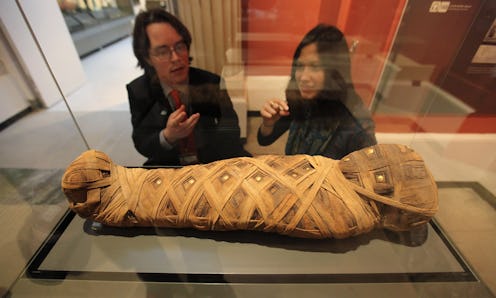Well, this is awkward. You know those mummies you may or may not have see in museums during school field trips or family outings? Yeah, sorry to burst your bubble, but you may not have actually seen mummies — because according to recent scans of the artifacts, about a third of mummies are just sculptures made of sticks and mud. Also, everything you think you know about ancient history is wrong.
Scientists at Manchester Museum and the University of Manchester used X-rays and CT scans to examine over 800 mummies of animals including crocodiles, birds, and cats — because it's always good to have some variety. They found that about a third contained no animal matter whatsoever, another third contained complete animals, and the remaining third were sort of a modge-podge of different animal parts and sculpting materials like eggshells and feathers (yum).
Those who conducted the study postulate that since animal mummies were religious offerings, not means to send bodies off into the afterlife as they were for humans, the ancient Egyptians needed more of them than actual animals could provide. Those gods were demanding!
People would buy the mummies and give them to priests, who would then bury them in giant tombs filled with mummies of the same species. (Anyone else just get a disturbing image of a hole in the ground filled with dead crocodiles — or, as the case may be, crocodile sculptures?)
Ew. Anyway, in case the world as you know it isn't already disintegrating — ARE OUR LIFETIMES JUST ONE GIANT HALLOWEEN NIGHT?!? — here are some other myths you probably believed about ancient civilizations, squashed.
1. Belief: Ancient Egyptians were white.
You guys, Egypt is in Africa. Why would its natives look like Christian Bale? Come on now. In all seriousness, though, it would be offensive to impose American racial definitions like "black" and "white" on a society that existed long before those concepts came into being. If you're curious, there is a ton of debate about the skin pigmentation and geographical origin of ancient Egyptians, but one thing's for sure: they did not resemble the cast of Exodus: God and Kings.
2. Belief: Ancient Romans were white.
Nope, not them either! Well, some of them — but much of the empire was in Africa and the Middle East, and even two Roman emperors were of African descent! As J. Wisniewski points out on Cracked, despite what popular media might tell you, any historically accurate cast of a film about ancient Rome should be "roughly as white as the cast of Lawrence of Arabia." After all, conquering the world is kind of hard to do if you're only willing to recruit white people to your empire.
3. Belief: Ancient Egyptians worshiped cats.
Well, sort of. They did hold cats in such high regard that killing a cat, even accidentally, immediately incurred the death penalty. And they did worship a goddess, among other gods and goddesses, that took the form of a cat. But they weren't kneeling down in front of altars occupied by their pets. According to Luke McGarrity, a graduate student at the University of Birmingham studying ancient Egypt, in this Ask A Historian Reddit thread, ancient Greeks Herodotus and Diodorus Siculus are to blame for the "worshipping cats" myth. Rest assured, though, people who believe cats are the pinnacle of life on Earth are real (and correct).
4. Belief: Slaves built the ancient Egyptian pyramids.
Due to depictions of ancient Egypt in movies like Exodus: God and Kings, the Egyptian pyramids conjure up images of slaves, well, slaving away at all those stones. But actually, the pyramid builders were buried right next to their pharaohs' pyramids with generous gifts for the afterlife — something that would never happen to slaves after death. So, they were most likely paid laborers highly respected for their construction skills. Once again, we owe this myth to Herodotus.
5. Belief: Those ancient Romans, man, they were all about those orgies.
Yes, there is art from ancient Rome depicting various sexual acts, as there is from virtually every civilization. No, this does not mean they were a sex-crazed or even sexually liberated people. J. Wisniewski's Cracked piece also takes on the myth of the orgiastic Romans, citing counterexamples such as the custom of ancient Roman married couples occupying separate beds and having sex with clothes on to protect the women's honor (those dirty sluts, taking clothes off to have sex with their husbands). This time, Christian proselytizers looking to take down ancient Roman religion are at fault for perpetuating the myth.
Images: Giphy(5); Marie-Lan Nguyen/Wikimedia Commons
